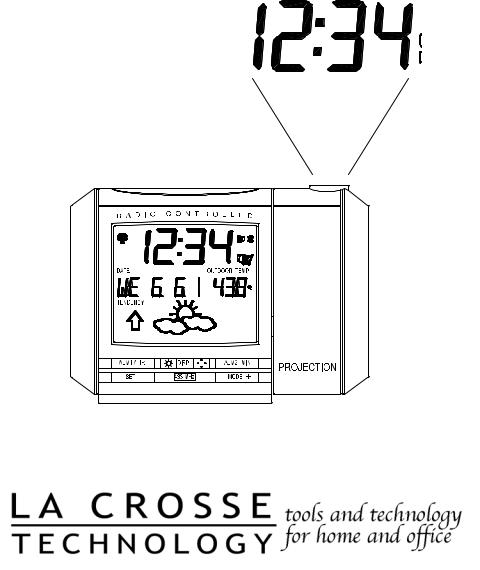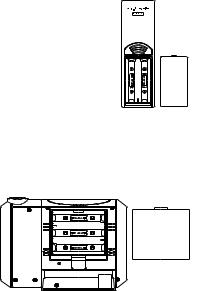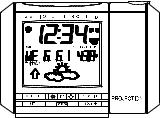La Crosse Technology WT-5432 User Manual

WT-5432
433 MHz
Radio Controlled Projection Alarm
Instruction Manual
TABLE OF CONTENTS
Topic |
Page |
Inventory of Contents/ Additional Equipment |
3 |
About WWVB |
3 |
Quick Set-Up Guide |
4 |
Detailed Set-Up Guide |
|
Battery Installation |
5-6 |
Program Mode |
|
Programming Sequence |
6 |
Function Buttons |
6 |
Time Zone Setting |
6-7 |
DST (Daylight Saving Time) Setting |
7 |
Adjustable Snooze |
7 |
Time Setting |
8 |
Date Setting |
8 |
12/24-Hour Setting/Selecting °F or °C |
8 |
Features & Operations |
|
Features |
9 |
Radio-Controlled Time |
9 |
Projection of time and/ or remote temperature |
10 |
Forecast Icon |
11 |
EL Backlight |
11 |
Indoor Temperature |
12 |
Remote Temperature |
12 |
Time Alarm |
13 |
Changing Display Mode (viewing seconds) |
14 |
Mounting |
15 |
Maintenance & Care |
16 |
Troubleshooting |
17 |
Specifications |
18 |
Warranty and Contact Information |
19-20 |
2
INVENTORY OF CONTENTS
1)WT-5432 projection alarm
2)TX6U remote temperature sensor
3)AC adapter/transformer (6V)
4)Instruction manual and warranty card.
ADDITIONAL EQUIPMENT (not included)
1)Three fresh 1.5V AA batteries (optional for alarm clock)
2)Two fresh 1.5V AA batteries (for remote transmitter)
ABOUT WWVB (Radio Controlled Time)
The NIST (National Institute of Standards and Technology—Time and Frequency Division) WWVB radio station is located in Ft. Collins, Colorado, and transmits the exact time signal continuously throughout the United States at 60 kHz. The signal can be received up to 2, 000 miles away through the internal antenna in the projection alarm. However, due to the nature of the Earth’s Ionosphere, reception is very limited during daylight hours. The projection alarm will search for a signal every night when reception is best. The WWVB radio station derives its signal from the NIST Atomic clock in Boulder, Colorado. A team of atomic physicists is continually measuring every second, of every day, to an accuracy of ten billionths of a second per day. These physicists have created an international standard, measuring a second as 9,192,631,770 vibrations of a Cesium-133 atom in a vacuum. For more information about WWVB please see the NIST website at http://www.boulder.nist.gov/timefreq/stations/wwvb.htm
QUICK SET-UP GUIDE
Hint: Use good quality Alkaline Batteries and avoid rechargeable batteries.
1.Have the indoor station and outdoor remote 3 to 5 apart.
2.Batteries should be out of both units for 10 minutes.
3.Place the batteries into the outdoor remote first then into the indoor station. (All outdoor remotes must be started before the indoor station)
4.DO NOT PRESS ANY BUTTONS FOR 10 MINUTES.
In this time the display and sensor will start to talk to each other and the display will show both the indoor temperature and an outdoor temperature. If the station does not display both temperatures after the 10 minutes please retry the set up as stated above.
After both indoor and outdoor temperatures are displayed for 10 minutes you can place your sensor outdoors and set your time.
The remote sensor should be placed in a dry, shaded area. The remote sensor has a range of 80 feet. Any walls that the signal will have to pass through will reduce distance. An outdoor wall or window will have 20 to 30 feet of resistance and an interior wall will have 10 to 20 feet of resistance. Your distance plus resistance should not exceed 80 ft. in a straight line.
3

NOTE: Fog and mist will not harm your remote sensor but direct rain must be avoided.
To complete the set up of your temperature station after the 10 minutes have passed please follow the steps starting on page 6.
DETAILED SET-UP GUIDE
Important: Insert batteries into the transmitter first, then into the alarm clock. Do not press any buttons until remote temperature is displayed.
I.BATTERY INSTALLATION
A.Remote Temperature Sensor
1.Remove the battery cover.
2.Observing the correct polarity, install 2 AA batteries.
3.The batteries will fit tightly to avoid start-up problems make sure that they do not spring free during installation.
4.Replace the battery cover.
B.Projection Alarm
Battery
Cover
1.Remove the battery cover.
2.Observe the correct polarity, and install 3 AA batteries.
3.In addition to, or instead of inserting batteries, the AC adapter can be used. Simply insert the adapter into the receptacle on the underneath
of the alarm clock and then plug the adapter into the wall socket.
4.Replace the battery cover.
The projector will activate and remain on if the alarm clock is plugged in. If only batteries are used, the projector will only be activated when a button is pressed. The projection is a red light, not harmful under normal usage, although care should be taken to not look directly into the light.
Note: After the batteries have been installed a tone will sound, and the LCD (Liquid Crystal Display) will activate. The indoor temperature and the remote temperature will be displayed (within three minutes). Also, the time will appear as “-:--”. The WWVB search is automatically initiated, and a tower icon appears and flashes with the time colon (no tower icon will appear if the WWVB is too weak to be detected, and the time display will remain on “-:--”). While
4

the WWVB search is being conducted various numbers will appear in the time display. After 10 minutes, the projection alarm will either display the WWVB time or discontinue the search if the time is not found. If the search is cancelled “-:--” will remain in the time LCD. The projection alarm will conduct a WWVB search every hour until the first signal is found. Once the WWVB time is found, a search is automatically conducted nightly at midnight. If the signal is found at midnight the tower icon will remain. If the signal is not found another search will take place every hour, until 6:00 am, until the signal is found successfully. If no signal is found during this period the tower icon will not appear and the clock will search again at 12:00 am the next night.
II.Program Mode
To enter the program mode, hold down the “SET” button for 1 second until the time zone, “-5” which is the default setting, flashes in the lower left. Press and release the “SNOOZE” button at any time to exit the program mode or wait approximately 15 seconds for the projection alarm to automatically return to normal operation.
A. Programming Sequence
1.Time Zone Setting
2. Daylight Saving Time ON/OFF
3. Adjustable Snooze
4. Hour Setting
5. Minute Setting
6. Year Setting
7. Month Setting
8. Date Setting
9.Day Setting
10.12/24-hour Mode
B.Function Buttons
There are 7 function buttons located on the front of the projection alarm and one on the top. The function buttons are labeled: “ALM1/HOUR”, “ALM2/MIN”, light intensity icon, “DISPL”, light direction icon, “SET”, “MODE/+”, and
“SNOOZE” (the top bar).
C.Time Zone Setting
1.Hold down the “SET” button for 1 second.
2.The time zone (“-5” default) will flash in the Date LCD.
3.Press and release the “+” button to select the appropriate time zone.
There are 13 time zones to choose from (based relative to the international time standard of GMT (“Greenwich Mean Time).
5
